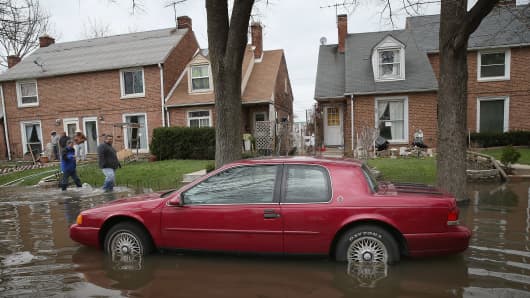Flood fighters from small Mississippi River hamlets to the suburbs of Chicago staged a feverish battle Friday to hold back raging rivers, after days of torrential rains soaked much of the Midwest.
Mississippi River communities in Iowa, Illinois and Missouri are expected to see significant flooding—some near-record levels—by the weekend, a sharp contrast to just two months ago when the river was approaching record lows. Michigan, Wisconsin and Indiana had flooding, too. All told, dozens of Midwestern rivers were well over their banks after rains that began Wednesday dumped up to 6 inches of new water on already saturated soil.
In Quincy, Ill., the normally slow to swell Mississippi River rose nearly 10 feet in 36 hours, National Weather Service hydrologist Mark Fuchs said. A bridge could be shut down and the sewage plant was threatened.
"That's pretty amazing," Fuchs said of the fast-rising river. "It's just been skyrocketing."
Smaller rivers in Illinois seemed to be causing the worst of the flooding. In suburban Chicago, which got up to 7 inches of rain in a 24-hour period ending Thursday, record levels of water were moving through the Des Plaines River past heavily populated western suburbs and into the Illinois River to the south.
As many as 1,500 residents of the northern Illinois town of Marseilles were evacuated after nine barges broke free from a tugboat and struck a levee on the Illinois River. The swollen Spoon River topped a levee and inundated the central Illinois town of London Mills, and about half of the 500 residents had to be evacuated. Police Chief Scott Keithley said some homes were half under water, and abandoned cars were sent floating in the torrent of water.
Mississippi River flooding wasn't as pronounced as its water level varies greatly but is typically highest in the spring, so minor flooding is not uncommon. "Flood stage" is a somewhat arbitrary term that the National Weather Service says is the point when "water surface level begins to create a hazard to lives, property, or commerce."
When river levels exceed flood stage by several feet, serious problems can occur. Just days ago, the Mississippi was well below flood stage. Forecasters now expect it to climb up to 12 feet above flood stage at some spots in Missouri and Illinois.
Already, high water has closed hundreds of roads and swamped hundreds of thousands of acres of farmland as planting season approaches. If it spills into sewage plants, waste could flow untreated into the river.
After the devastating Mississippi River floods of 1993, the government bought out thousands of homes that were once in harm's way, tore them down and replaced them with green space where development is not allowed. New and bigger levees have been built, and flood walls reinforced.
Clarksville, Mo., is one of the few places at the mercy of the river. The quaint community of 442 filled with century-old historic homes has no flood wall or levee. But in 2008, it purchased a flood protection system that allows for a levee to be constructed—aluminum slats filled with sand—if the river rises.
The waters have risen too quickly to install the system this time, so volunteers are using gravel, plastic overlay and sandbags to protect the business district, and they're layering sandbags around threatened homes, the American Legion hall and the Catholic church.
"This just shocked us all because it just came up so quickly," alderwoman Sue Lindemann said. "We found out about the crest prediction Wednesday and we started sandbagging that night. It's going to be touch and go but we're hoping."
Lindemann said Clarksville has opted against a levee or flood wall partly because of the cost, and partly because residents like the view.
Also unprotected is Grafton, Ill., a tourist town near St. Louis that sits at the convergence of the Mississippi and Illinois rivers. But flooding happens so often there that people are taking it in stride.
"If you live here, you understand the river," Mayor Tom Thompson said. "We'll get through this."
The main thoroughfare leading into town—the Great River Road—was expected to be closed off by midday Saturday, and riverside merchants were clearing out merchandise. Among them was Laurie Wild, 51, who scrambled with volunteers to save her artisan shop's wares—jewelry, pottery, textiles and wood carvings.
"It's a mess," the St. Louis transplant said. "We knew what we were getting into when we moved here. It's a beautiful town, and we'll be here after."
Widespread flash-flooding accompanied the week's rains. An 80-year-old woman died in De Soto, Mo., about 40 miles southwest of St. Louis, when a creek flooded a street and swept away her car.
Missouri Gov. Jay Nixon declared a state of emergency because of "rapidly rising rivers" and activated the Missouri National Guard for deployment to threatened Mississippi River towns.
And in Michigan, Midland County Sheriff Scott Stephenson said a "major" rupture emerged in the Kawkawlin Dam, a 12-foot breach sending water through the structure. There were no reports of injuries.


